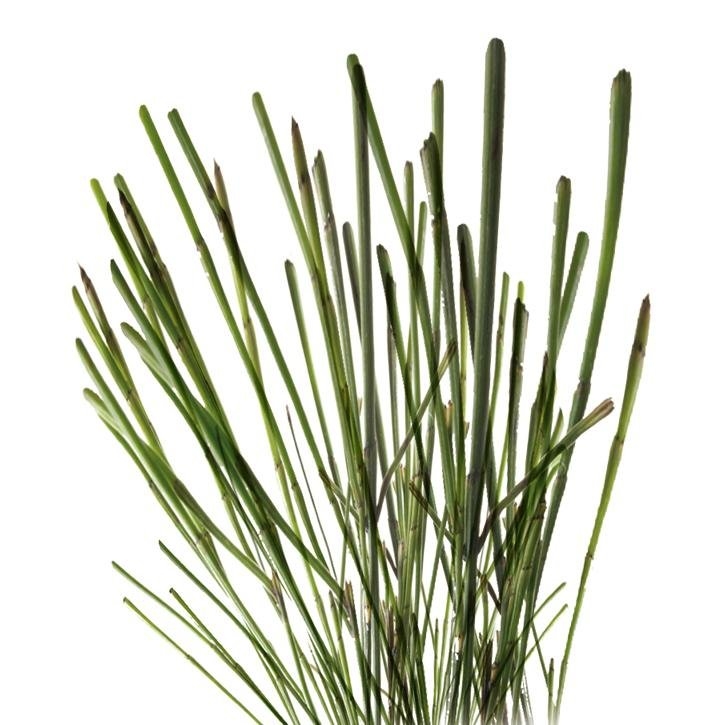Description
This perennial herbaceous plant is a fern of 20-60 cm length, with a black rhizome. Stems are aerial and erect (20-60 cm long) and articulated with marked nods of brittle and longitudinal grooved surface. Leaves are microphyll kind (small, with a middle non-branched nerve), joined together terminating in sheathes, with 6 to 12 black teeth. The aerial stems are of two kinds: fertile stems (smaller and reddich-brown or yellow) and barren stems (taller and green).
These are very primitive plants that were related to ferns and there are around 50 different species known, around the world; most of them in the North Hemisphere. They have no flowers nor seeds and as ferns are reproduce by spores. They belong to the Equisateaceae family.
Horsetail grows widely distributed around the mild weather zones of the north hemisphere in Asia, North America and Europe. It is found in hedgebanks, non-cultivated soils, sandy, humid and clayey terrain, in streams, etc. in most parts of the Iberian Peninsula, especially at the northern part. The barren stems are harvested in spring and summer.
Part used
Barren stems, fresh or dried. Fertile stems have no medicinal value.
Indications
Internal use
- Osteomuscular disorders: osteoporosis, fractures, rheumatism, rachitism, arthritis, arthrosis, etc.
- Genitourinary disorders: cystitis, urethritis, prostatitis, urethritis, pyelonephritis, renal lithiasis, vulvovaginitis, enuresis.
- Oliguria, edemas, post-traumatic edema and urinary retention.
- Hyperazotemia, hyperuricemia, gout.
- Sportspeople: ligament distention, joints damage, whenever greater physical effort is required.
- As a helper in treating obesity with liquid retention, weight swinging, cellulite, etc.
- Lung infections: tuberculosis (these people show low levels of silica) bronchitis.
- Asthenia, fatigue and convalescence.
- Hemorrhage: hematuria (blood present in urine), metrorrhagia (abnormal uterine bleeding), hypermenorrhea (heavy menstrual flow), hemoptysis (coughing up of blood from the respiratory tract) intestinal hemorrhages, etc.
- Hyperchromic anemia or by medullary deficiency.
- Arterial hypertension.
- Arteriosclerosis prevention (people suffering from this disease show low silica levels. Silica helps to fix and use calcium in the body and protects arteries against fatty deposits).
- Prevention of baldness, dandruff, fragile and brittle fingernails, flabby skin, prevent and diminish stretch marks, wrinkles, restrain skin aging.
- Diarrhea.
- Gastroduodenal ulcers.
External use
- Hard to heal wounds, eczemas, dermatitis, erythema, torpid ulcer on the skin, abscesses, varicose ulcers, burns (poultice).
- Hemorrhages: epistaxis (nose bleeding) nose washes in cold, etc.
- Bleeding hemorrhoids (sitz baths)
- Sprains.
- Chillblains, plantar hyperhidrosis
- Oral disorders (gargles and washes): oral ulcerations, parodontopathies, stomatitis, pharyngitis.
- Corneal ulcerations, blepharitis, conjunctivitis, stye, swollen or painful eyes.
- Inflammation or infection in the vulva and vagina: vulvitis, vulvovagintis, vaginitis.
- Breast atony or mammary flaccidity (Internal use support).
- Weak and brittle hair, dandruff.
- Light bleeding colitis (enema).
- Horsetail decoctions concentrations can be used to combat plagues from the orchard, fruit trees, etc. in a very ecological way. It is also used to eliminate fungi and insects when used along with nettle.
Bibliography
Herbal Drugs and Phytopharmaceuticals. Norman Grainger Bisset (Ed). Max Wichtl. CRC Press.1994.
Plantas Medicinales y Drogas Vegetales para infusión y tisana. Edición española a cargo de: Salvador Cañogueral, Roser Vila, Max Wichtl.1998.
Plantas Medicinales. Margarita Fernandez y Ana Nieto. Ed Universidad de Navarra. EUNSA 1982.
The Complete German Commission E Monographs. Therapeutic Guide To Herbal Medicines. Mark Blumenthal. American Botanical Council 1998.
Fitoterapia: Vademecum de Prescripción. B. Vanaclocha, S. Cañigueral. Editorial Masson. 4ª edición.
Plantas Medicinales. El Dioscórides Renovado Pio Font Quer.
Pharmacognosy 9th edition. Varro E. Tyler – Lynn R. Brady – James E. Robbers.
Farmacognosia. Jean Bruneton. Editorial Acribia . 2ª edición.
Catálogo de Plantas Medicinales. Consejo General de Colegios Oficiales de farmacéuticos. 2003.
Fitoterapia Aplicada. JB Peris, G Stübing y B Vanaclocha. Colegio Oficial de Farmacéuticos de Valencia. 1995.
100 Plantes Medicinales. Max Rombi. Ediciones Romart. Deuxieme Edition.
